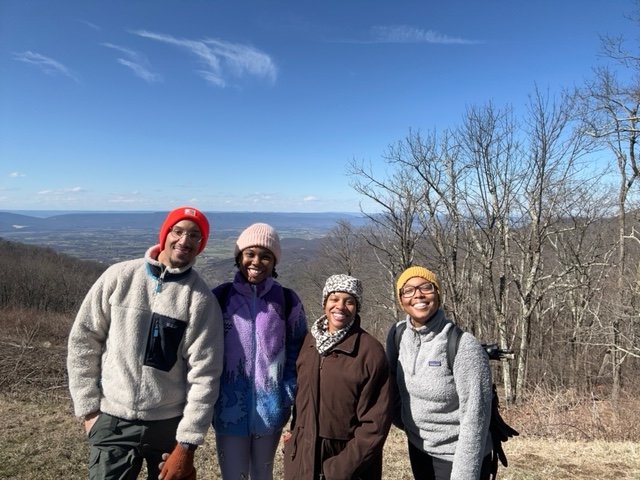Shenandoah National Park
Shenandoah National Park was a national park designed for recreation, evident in the many activities available to visitors, including hiking, camping, and wildlife watching. It was established in 1935, during the Great Depression, as a way to provide jobs and boost the local economy. The Civilian Conservation Corps was responsible for much of the construction work in the park, building trails, picnic areas, and campsites.
Our first stop was of course the Harry F. Byrd Visitor's Center to get our park passport stamped. The visitor’s center had an interactive exhibit which you could walk through to learn more about the park’s history and creation. Parts of the exhibit acknowledged that many Native people were displaced during the park’s construction.
Integral to the history of the park is the Black history of Lewis Campground. This campground was established in the 1930s as a segregated area for African American visitors. We were humbled to learn about the struggles and triumphs of the African American community in the area, and pay homage to the many who fought for civil rights in the area. We were welcomed by the director of the Sierra Club's Outdoors For All campaign, and founder and chair of the Outdoors Alliance for Kids Jackie Ostfeld, and invited to stay at her personal cabin, which was a short hike away from the Lewis Campground. It was quite the grounding experience to have free range in a park where our ancestors were relegated to certain corners.
Making use of the visitor’s center, we did our normal routine of asking for recommendations of things to do in the park. National parks are the gems of the United States, yet accessibility to these parks for many people still remains a barrier to experiencing them. During this visit we had a particular accessibility concern – Our Parks Too! co-founder Diamon Clark was 6 months pregnant! So to determine the best trails for her, as we've made it a routine to do, we consulted with park rangers at the visitor's center and learned about fire roads. Fire roads are rustic roads specifically made for fire management purposes. They also make great trail alternatives for hikers that need a level surface and gentle elevation changes. By utilizing fire roads within Shenandoah, we were able to experience popular views without the difficult hike to get there. While many parks are still working to improve accessibility features, there are infrastructure and programs in place that anyone can learn about by calling ahead to the park ranger hotline, checking the park website, or by visiting the visitor center. The park ranger recommended the Dark Hollow Falls Trail which took us on a journey through a lush forest, past cascading waterfalls, and over rocky terrain. The trail is rated as moderate and is suitable for hikers of all skill levels.
There are many different caverns in the Shenandoah area including Skyline, Luray, and Melrose. Caverns are a natural wonder, with stunning rock formations and a rich history that dates back thousands of years, and they make a great destination for family outings. We decided to visit the Grand Caverns which is the longest operating show cave in the country. We were led on a guided tour which provided fascinating insights into the history and geology of the area. The highlight of the tour is the Cathedral Room, a massive chamber with towering ceilings and stunning rock formations.
Our last stop before we left the area was Clementine Cafe near James Madison University in Harrisonburg, Virginia. The restaurant sources local ingredients whenever possible, and the dishes are always fresh and flavorful. The menu offers a variety of options, including vegetarian and gluten-free dishes, as well as classic comfort food favorites like burgers and mac and cheese. The restaurant is housed in a historic building, with exposed brick walls and cozy seating areas. The staff is friendly and welcoming, and they have live music on a regular basis.








